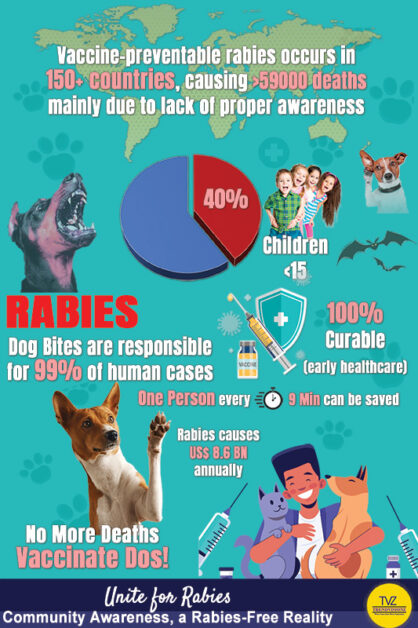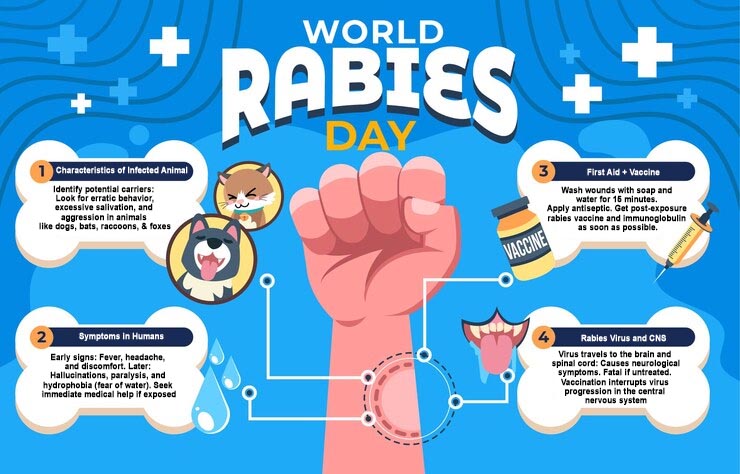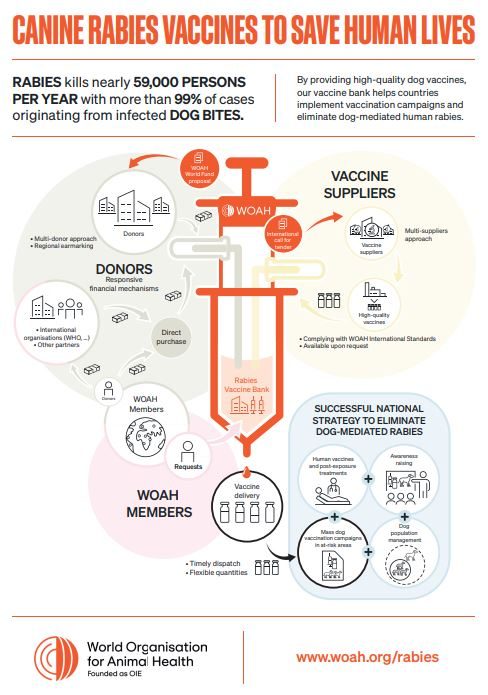In the shadow of the menacing rabies virus, humanity has long grappled with a formidable foe. This lethal pathogen transmitts through the saliva of infected animals. And strikes fear into the hearts of those who understand its deadly potential. How Does Rabies Work?
Rabies, a deadly zoonosis with a 4,000-year history, remains a global concern. While some regions have eliminated it, many parts of Africa and Asia still battle the disease. Rabies in humans is a rare but deadly viral infection transmitted through the saliva of infected animals. It largely impacts low-income nations due to limited resources.
Amid the darkness, there is a glimmer of hope! A testament to the power of global unity and unwavering determination.
Rabies disease is incurable once symptoms emerges. Recognizing the signs of rabies is crucial for swift intervention. Rabies can be preventable through recommended safeguards and swift action. This awareness-generative article delves into the global efforts. Through vaccination, awareness, and medical care. We are making strides towards a world where Rabies is a conqueror. Ensuring that no one needs to succumb to its grasp.

Also Read:
- 10 Strategies for Building Financial Wealth: Your Pathway to Abundance
- Unraveling the Mystery of Dengue Fever: 10 Warning Signs You Must Know
Tragic Loss: Ghaziabad Boy Succumbs to Rabies a Month After Dog Bite
In a real heartbreaking incident, a 14-year-old boy from Ghaziabad, Shahbaz, passed away on September 4. A month after being bitten by a neighbor’s dog. The family alleged that the dog was unvaccinated. Shahbaz initially applied turmeric to the wound, which seemed to heal. However, he began displaying rabies symptoms. Including hydrophobia and photo sensitivity, over his last four days. This tragic incident serves as a stark reminder of the continued significance of rabies prevention and awareness in 2023. Hope our article How Does Rabies Work? makes a serious attempt in saving one life every nine minutes from Rabies.
World Rabies Day 2023: Uniting for a Safer Tomorrow
As per WHO, Rabies disease claims around 59,000 lives each year, with children constituting 40% of the victims.

Every year on September 28, the Global Alliance for Rabies Control (GARC) observes World Rabies Day (WDR). An event recognized by the World Health Organization (WHO). The date pays homage to Louis Pasteur. The French scientist was the pioneer of the rabies vaccine, whose Work in science and healthcare continues to save lives.
The motto of 2023, underscores the importance of a collaborative approach. Involving professionals from human, animal, and environmental health sectors. To come together and end canine-transmitted human Rabies.

What is Rabies: How Does Rabies Work?
Rabies is a viral disease affecting mammals like dogs, cats, and humans. The virus predominantly resides in the saliva and brain of infected animals, primarily dogs. It spreads through bites.
The virus invades the central nervous system, leading to acute and fatal encephalomyelitis. In some areas, bats serve as reservoirs of spread. There is an abundant presence of the virus in wildlife, which increases the chances of cross-species transmission. Domestic animals and humans are the most vulnerable targets.
Rabies is a vaccine-preventable, zoonotic, viral disease affecting the central nervous system. Once clinical symptoms appear, Rabies is virtually 100% fatal. In up to 99% of cases, domestic dogs are responsible for rabies virus transmission to humans.
WHO
According to the WHO, there were 13,743.44 rabies deaths. Over the past 30 years, the global burden of Rabies has decreased across 204 countries. In 2018, the World Health Organization introduced a global strategic plan aiming to eliminate human rabies deaths by 2030.
These numbers, though staggering, are now on the decline. Thanks to widespread dog vaccination campaigns and increased awareness.
Crucial Rabies Facts: Understanding the Silent Threat
Rabies is a lurking terror responsible for tens of thousands of deaths annually. It predominantly strikes vulnerable populations in Asia and Africa.
Rabies earned its name from a Latin term that signifies “to rage.” Reflecting the fact that animals afflicted with Rabies often exhibit behavior resembling anger. As per WHO:

Also Read: Best 15-Minute Workout at Home No Equipment: A Beginner’s Guide
Rabies A Global Menace : How Does Rabies Work?
The vaccine-preventable viral disease, it is widespread in over 150 countries.
- Dog’s Deadly Role: Dogs, often considered our loyal companions. They are paradoxically the primary culprits behind human rabies deaths. Responsible for up to 99% of infections.
- Most Affected: Its grip is most severe in Asia and Africa, where 40% of victims are innocent children under 15.
- Low Awareness: About post-dog bite healthcare leading to over 55,000 annual deaths, mainly in Asia and Africa.
- Rabies Menace in India: India alone accounts for 36% of global rabies deaths, with an estimated 18,000-20,000 yearly fatalities. Shockingly, 30-60% of these cases involve children under 15, often due to unreported bites.
- Post-Exposure Lifeline: In the aftermath of contact with a potentially rabid animal. Hope emerges in the form of post-exposure prophylaxis (PEP).
- The Cost of Rabies: Globally, the price tag of Rabies extends far beyond human suffering, amounting to a staggering US$ 8.6 billion annually.
- One Health, One Goal: Embracing a holistic “One Health” approach rallies diverse sectors and local communities. Fostering awareness campaigns to combat this relentless foe.
- Zero Human Deaths by 2030: WHO
- Rabies is 100% preventable: WOAH

How Does Rabies Spread?
Rabies is transmitted to humans through contact with infected saliva via bites, scratches, or mucous membranes (eyes, nose, mouth). The most common way is through bites from rabid animals like dogs, cats, bats, raccoons, or foxes. Even minor scratches or abrasions can allow the virus to enter your body.
Once in the body, the rabies virus travels through the nerves to the brain. This process can take weeks or months, so signs and symptoms may not appear for some time after exposure. However, once symptoms start showing, Rabies is nearly 100% fatal without treatment. This is why post-exposure prophylaxis (PEP) treatment is critical immediately after potential exposure.
Once symptoms appear, Rabies disease is fatal if left untreated. The good news is Rabies in humans is preventable if you get proper medical care right away after exposure. Not all animal bites will transmit Rabies, but a doctor should evaluate any taste from a potentially rabid animal.
Also Read:
- Embracing Inner Child: Top Strategies & Self-Growth Approach
- Beyond the Myth: Do ‘Functional Foods’ Like Apples Keep Doctors Away?
Rabies Symptoms and Early Detection
The early signs of Rabies in humans can appear within days to years after exposure. Pay close attention if you’ve been bitten by an animal that could have Rabies, as the disease is nearly 100% fatal without treatment.
Pain or Tingling at the Bite Site
Once the rabies virus enters your body, it travels through the nerves to your brain and spinal cord. You may feel pain, itching, or tingling at the bite site as the virus starts to incubate. This can last for several days before other symptoms appear.
Fever and Headache
As the virus reaches your central nervous system, you may develop a fever, headache, nausea, and vomiting. The fever may be high, around 103 F to 104 F. These flu-like symptoms mean the rabies virus has become active in your body. Seek medical care immediately.
Hypersensitivity and Anxiety
You may become hypersensitive to light, sound, and touch. Anxiety, agitation, and confusion are also common as the virus impacts your brain.
Difficulty Swallowing
The rabies virus can cause inflammation of the throat and esophagus, making it difficult and painful to swallow. This is known as hydrophobia (“fear of water”) since even the thought of swallowing liquid can induce spasms.
Muscle Spasms and Paralysis
As the virus spreads through your spinal cord and brain, it can cause muscle spasms, weakness, and even paralysis. This includes lockjaw, making it difficult to open your mouth. Paralysis will eventually lead to respiratory and cardiac failure without treatment.

More severe symptoms emerge as the disease advances:
- Confusion or hallucinations
- Partial paralysis
- Hydrophobia – Anxiety attacks caused by the presence of water
- Insomnia
- Anxiety
- Agitation
- Excessive salivation
Unfortunately, there is no cure for Rabies once symptoms start showing. However, with proper PEP treatment after exposure, Rabies can be prevented. PEP includes:
- Thorough wound cleansing
- A dose of Rabies immune globulin
- Four rabies shots spaced out over 14 days.
The only way to confirm a rabies diagnosis is through a blood test, skin biopsy, or postmortem brain tissue testing. Early treatment, like the rabies vaccine and immunoglobulin, works by neutralizing the virus before it can do damage. So don’t delay if you’ve been exposed—get treated right away. Your life could depend on it.
Why There’s No Cure: How Does Rabies Work
The rabies virus affects the central nervous system, causing death in its victims. As Rabies enters the body, usually through a bite or scratch from an infected animal, it travels through the nerves to then brain and spinal cord. The virus causes inflammation of the brain and spinal cord, known as encephalitis and myelitis. This results in the symptoms we commonly associate with Rabies. Like agitation, hallucinations, and hydrophobia (fear of water).
Is Rabies 100% Fatal in Humans?
While Rabies is nearly 100% fatal once symptoms appear. The good news is it is preventable if treated right away after exposure. The rabies virus spreads through the saliva of infected animals. And enters the body through open wounds or mucous membranes.
Sadly, by the time symptoms appear, Rabies has already done major damage. The virus essentially takes control of the central nervous system. And rapidly multiplies and destroys nerve cells. This damage is irreversible and untreatable. Even with the best medical care, Rabies is nearly deadly. Specially once symptoms start without prior vaccination.
The only way Rabies can be stopped before symptoms show is by administering Rabies post-exposure prophylaxis or PEP. This includes thoroughly cleaning the wound. Vaccination with rabies immunoglobulin. And four doses of rabies vaccine given over 14 days. The PEP works by prompting your body to produce rabies antibodies before the virus can spread and do damage.
In developing countries, Rabies still causes thousands of deaths mostly in children. The majority of these deaths is preventable. It remains an ongoing threat, especially in areas of the world with limited access to prevention and treatment. By understanding how Rabies impacts the body, we can work to stop this deadly virus in its tracks.
How Does Rabies Work: Treatment Strategies
The good news is Rabies can be prevented if treatment is administered promptly after exposure. The bottom line: Any potential rabies exposure is a medical emergency. Prompt vaccination and medical care are the only ways to prevent this fatal disease.
Treatment for Rabies in Humans: A Step-by-Step Guide
Treating Rabies in humans is a race against time due to the virus’s rapid progression. The process involves:
- Immediate Wound Care: Thoroughly washing the bite or scratch with soap and water for 15 minutes helps remove the virus.
- Vaccination: A series of rabies vaccine shots is administered to stimulate the immune system. This includes an initial dose and additional shots over the following weeks.
- Rabies Immunoglobulin: In some cases, this lifesaving treatment is injected around the wound
- Hospitalization: Patients are closely monitored in a medical facility, as rabies symptoms may take time to appear.
- Supportive Care: Symptomatic treatment is provided. Early intervention is key to survival.
Understanding the Vaccines: How Does Rabies Work?
Rabies vaccines are critical for preventing this Rabies in humans. While Rabies is commonly transmitted through animal bites. The rabies virus can enter your body through any break in the skin.
Rabies vaccines Work by stimulating your immune system to produce antibodies against the rabies virus. This helps ensure that if you are exposed to Rabies in the future, your body can quickly respond and prevent the virus from infecting you. The rabies vaccine is very effective at avoiding Rabies if given before exposure or immediately after exposure.
The rabies vaccine schedule typically involves three shots over a four-week period: initial dose, and subsequent doses on days 7 and 21 or 28.
Is 3 Shots of Anti Rabies Enough?
Three shots of the rabies vaccine are generally sufficient for post-exposure prophylaxis. However, the treatment regimen may vary based on factors like the severity of exposure. Consult your healthcare provider for personalized guidance.
The rabies vaccine is recommended for:
- Anyone traveling to an area where Rabies is common and immediate medical care may not be available
- Veterinarians, animal handlers, and others who frequently interact with animals
- Anyone whose hobbies or occupations put them at high risk of exposure to Rabies
Common Side Effects of Rabies Vaccine:
Include redness, swelling, and soreness at the injection site. Extreme symptoms, such as an allergic reaction, are uncommon. The benefits of preventing a fatal disease like Rabies greatly outweigh the risks of vaccination for most people.
While no vaccine is 100% safe, the rabies vaccine is considered very safe and effective. Talk to your doctor about whether the rabies vaccine is right for you based on your risk factors. For the best protection, be sure to follow the recommended vaccination schedule and get booster shots if needed. Rabies is preventable—get vaccinated and avoid the alternative.
Preventing Rabies: 8 Vital Steps for Society
Rabies, with its 100% mortality rate, leaves no room for complacency. To safeguard against dog bites, especially among children, here are crucial steps every community can take:
- Awareness Matters: Understand that Rabies can affect anyone. Ignorance can lead to complacency.
- Community Action: Raise the topic of rabies prevention in society meetings. Ensure all pets are not only claimed to be vaccinated but also provide vaccination certificates as proof.
- Segregation and Supervision: Separate playtimes and spaces for kids and pets to reduce risks.
- Advocate for Leash Laws: Push for strict leash regulations in common areas to maintain safety.
- Educate Children: Inform kids about the dangers of dog bites and encourage them to report any contact with dogs.
- Care for Strays: Encourage pet lovers to take responsibility for vaccinating and caring for stray dogs in your area.
- Address Problems: Follow local procedures to deal with problematic dogs without fear of backlash from NGOs or dog enthusiasts.
- Medical Attention: In the event of a dog, cat, or monkey bite, consult a doctor in person, regardless of the severity of the pet’s vaccination status. One visit can save lives.
Rabies in Animals: How They Get It and Spread It
Rabies is not exclusive to humans; it affects animals, too, posing significant risks to both wildlife and domesticated species. Understanding how animals contract and transmit this deadly virus is crucial for managing its spread.
How Animals Contract Rabies:
- Bites from Infected Animals: The primary mode of transmission is through bites from rabid animals. When an infected animal’s saliva enters the bloodstream of another through a bite, the virus can take hold.
- Contact with Saliva: Rabies can also spread if the saliva of an infected animal comes into contact with open wounds, mucous membranes (eyes, nose, mouth), or broken skin.
- Shared Food and Water Sources: In some cases, Rabies can be transmitted when multiple animals share food or water sources contaminated with the saliva of an infected carrier.
Rabies Symptoms in Dogs
Dogs primarily contract rabies through the bite of an infected animal. The virus is transmitted through saliva, entering the bloodstream. It’s crucial to vaccinate pets to prevent rabies transmission.
Rabies symptoms in dogs include behavioral changes, excessive salivation, and aggression. Vaccination is crucial for preventing and managing rabies in pets.
Common Rabies Carriers:
- Wildlife: Wild animals, such as bats, raccoons, skunks, and foxes, often serve as natural reservoirs for the rabies virus.
- Domestic Animals: Domesticated animals like dogs, cats, and livestock can contract Rabies if a rabid animal bites them.
Preventing Rabies in Animals:
- Vaccination: Vaccinating domestic animals, especially dogs and cats,.
- Avoiding Wildlife Interaction: Minimizing contact between domesticated animals and wildlife
- Immediate Quarantine: If a pet is bitten by a potentially rabid animal, quarantining and observing the pet
Rabies in animals underscores the importance of responsible pet ownership. And wildlife management to break the chain of transmission. It protect both animal and human populations.
Also Read: What About True Love: Shield Against Relationship Disconnect
Bali’s Triumph: A Rabies Success Story
Bali, Indonesia, once grappling with the scourge of Rabies, has emerged as a success story in the battle against this deadly virus. Rabies arrived on the island in 2008, triggering a rising tide of human fatalities, reaching over 140 deaths. An estimated dog population of 350,000, mainly roaming freely as ‘community dogs.’ The early response focused on culling, while vaccination took a backseat.
A turning point came in 2010 when the Bali Animal Welfare Association (BAWA) launched mass vaccination campaigns for free. Supported by organizations like the World Society for the Protection of Animals and AusAID. This shift yielded a sharp drop in new rabies cases in humans.

Recognizing this success, the Indonesian Directorate of Animal Health sought FAO’s technical support to maintain momentum and combat Rabies effectively. FAO, alongside human health services, NGOs, and animal welfare groups, collaborated to create a unified front against Rabies.
As a result of coordinated efforts, over 70% of Bali’s dog population has been vaccinated, creating ‘herd immunity.’ Rabies deaths plummeted from 83 in 2010 to just seven in 2012. However, continued vigilance and vaccination are vital to secure a rabies-free Bali.
FAQs: How Does Rabies Work?
Do all dogs have Rabies?
No, Rabies is spread by infected animals. Not all dogs or wild animals have Rabies. Rabies is transmitted through contact with the saliva of a rabid animal, usually via bites.
How is it transmitted to humans?
Rabies is usually spread to humans through bites from infected animals like dogs, bats, foxes, raccoons, and coyotes. Non-bite exposure, like scratches, can also transmit Rabies. If infected saliva comes in contact with mucous membranes or an open wound.
Is Rabies curable?
No, once symptoms appear, Rabies is nearly 100% fatal if left untreated. However, Rabies can be prevented if treatment is administered before symptoms start. The rabies vaccine and rabies immunoglobulin can prevent the onset of symptoms if given shortly after exposure.
Conclusion
You now know the scary facts about how Rabies works. And how easily it can be transmitted to humans. The key is to become aware and prevent it with education. Hope this attempt – How Does Rabies Work , helped you become aware. Immediate medical attention is paramount if signs of rabies in humans manifest.
Make sure your pets are vaccinated, and teach your kids not to approach wild animals. Stay safe out there and spread the word – Rabies in humans is rare but serious.
So, we all need to do our part to stop this deadly virus in its tracks. The life you save could be your own.
Our Digital Imprints:
Anuj Mahajan is a Mass Communication Specialist,
ICF Certified Coach & Corporate Trainer. Motivational Speaker / NLP Lifecoach.
Chief Operating Officer: Nuteq Entertainment Pvt Ltd, and
Co-Founder: Trendvisionz – A Premier Digital Marketing Agency in India
Get Connected to us with our Newsletters-Transforming Lives… Creating the magic. Just – Believe ~ Practice ~ PerformBizTech Chronicle… Navigating Tomorrow’s Tech Frontiers 🚀
Join my LinkedIn Group: Digital Marketing, Content Creation World Group
Follow me on Twitter or LinkedIn. Check out my website.






1 comment
A complete information about Rabies.Thanks for sharing information.
Comments are closed.